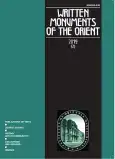The Layman İndu and an Old Uighur Poem
- Authors: Zieme P.1
-
Affiliations:
- Berlin Brandenburg Academy of Sciences and Humanities
- Issue: Vol 5, No 2 (2019)
- Pages: 39-48
- Section: Original Papers
- Published: 15.12.2019
- URL: https://journals.eco-vector.com/2410-0145/article/view/25875
- DOI: https://doi.org/10.17816/wmo25875-
- ID: 25875
Cite item
Full Text
Abstract
Edition of an Old Uighur poem preserved on the verso side of SI 4959 (Kr I 18) of the Serindia Collection of the Institute of Oriental Manuscripts. The fragment contains twelve stanzas à four lines. The contents is difficult to define, It is assumed that stanzas I to VI refer to an unnamed young boy who may be a Buddhist novice, while stanzas VII to XII emphasize the importance of doing punya, good deeds. The layman İndu is presented as a model. In stanza IX he vows to encounter with Maitreya expressed in an indirect way. Similar verses are known from Maitreya poems. The paper presents a full edition of this fragment with some notes on problematic words and phrases.
About the authors
Peter Zieme
Berlin Brandenburg Academy of Sciences and Humanities
Author for correspondence.
Email: ziemepet@gmail.com
Germany
References
- Bai YUDONG and Matsui DAI 白玉冬 & 松井太 2017: フフホト白塔のウイグル語題記銘文 „Old Uighur Inscriptions of the White Pagoda, Hohhot“. In: Studies on the Inner Asian Languages XXXI, 29–77.
- TEZCAN, Semih 1974: Das uigurische Insadi-Sūtra, Berliner Turfantexte III. Berlin: Akademie-Verlag.
- ZIEME, Peter 1985: Buddhistische Stabreimdichtungen der Uiguren, Berliner Turfantexte XIII. Berlin: Akademie-Verlag.
- WILKENS, Jens 2007: Das Buch von der Sündentilgung. Edition des alttürkisch-buddhistischen Kšanti Kılguluk Nom Bitig I–II. Turnhout: Brepols Publishers.
- Drevnetjurskij slovar’. Leningrad, 1968.
- CLAUSON, Gerard 1972: An Etymological Dictionary of Pre-Thirteenth-Century Turkish. Oxford.
- Gabain, Annemarie v. 1976:“Ein chinesisch-uigurischer Blockdruck”. In: Tractata altaica Denis Sinor sexagenario optime de rebus altaicis merito dedicata. Wiesbaden: Harrassowitz, 203–210.
- HAUENSCHILD, Ingeborg 2003: Die Tierbezeichnungen bei Mahmud al-Kaschgari. Eine Untersuchung aus sprach- und kulturhistorischer Sicht, Wiesbaden: Harrassowitz.
- JARRING, Gunnar 1964: An Eastern Turki-English Dialect Dictionary. Lund: CWK Gleerup.
- JUDACHIN, K.K. 1965: Kirgizsko-russkij slovar’. Moscow.
- KITSUDŌ, Kōichi 2011: “Two Chinese Buddhist Texts Written by Uighurs”. In: Acta Orientalia Academiae Scientiarum. Hungaricae 64, 325–343.
- LAUT, Jens Peter 2011: “Mustafa İnan und das Suffix –inti”. In: Hoşsohbet Erika Glassen zu Ehren. Würzburg: Ergon Verlag, 195–219.
- LI Gang 2016: “An Old Uighur Fragment in Alliterative Verses Preserved in the Turfan
- Museum”. In: Studies on the Inner Asian Languages 31, 21–27.
- MAUE, Dieter 1996: Alttürkische Handschriften Teil 1: Dokumente in Brāhmī und tibetischer Schrift. Stuttgart: Franz Steiner Verlag.
- MIRKAMAL, Aydar 2010: “The Uighur Madhyama Āgama Fragment Preserved in the Gest Collection of Princeton University Library”. In: Kyoto University Linguistic Research 29, 1–26.
- RÁSONYI, László and BASKI, Imre 2007: Onomasticon Turcicum. Turkic Personal Names, I–II. Bloomington: Indiana University Denis Sinor Institute for Inner Asian Studies.
- SWTF 1994–2018: Sanskrit-Wörterbuch der buddhistischen Texte aus den Turfan-Funden. Göttingen: Vandenhoek and Ruprecht.
- UWN 2017: K. Röhrborn. Uighurisches Wörterbuch. Sprachmaterial der vorislamischen türkischen Texte aus Zentralasien – Neubearbeitung – II. Nomina – Pronomina – Partikeln. Band 2: aš – äžük. Stuttgart: Steiner Verlag.
- UWV 2010: K. Röhrborn. Uigurisches Wörterbuch. Sprachmaterial der vorislamischen türkischen Texte aus Zentralasien – Neubearbeitung – I. Verben. Stuttgart: Steiner Verlag.
- WILKENS, Jens 2017: “The Old Uyghur translation of the Bieyi za ahanjing”. In: The Old Uyghur Āgama fragments preserved in the Sven Hedin collection, Stockholm, Turnhout: Brepols, 197–280.
- ZIEME, Peter 1991: Die Stabreimtexte der Uiguren. Studien zur altuigurischen Dichtung. Budapest: Akadémiai Kiadó.
- „A Brāhmaṇa Painting from Bäzäklik in the Hermitage of St. Petersburg and Its Inscriptions“. In: T. Pang and S.-Chr. Raschmann and G. Winkelhane (edd.). Unknown Treasures of the Altaic World in Libraries, Archives and Museums. 53rd Annual Meeting of the Permanent International Altaistic Conference, Institute of Oriental Manuscripts, R[ussian] A[cademy of] S[ciences] St. Petersburg, July 25–30, 2010. Berlin: Klaus Schwarz Verlag 2013, 181–195.
- „Paul Pelliot and tärim“. In: Journal of Sino-Western Communications 7 (2015), 147–257.
- Zwischen Thron und Misthaufen. Die Geschichte von Anāthapiṇḍika in einer altuigurischen Blockdruck-Version, academia.edu 2017.
- “Kaniska in the Old Turkic Tradition”. In: Great Journeys across the Pamir Mountains. A Festschrift in Honor of Zhang Guangda on his Eighty-Fifth Birthday. Leiden-Boston: Brill 2018, 176–185.
Supplementary files







